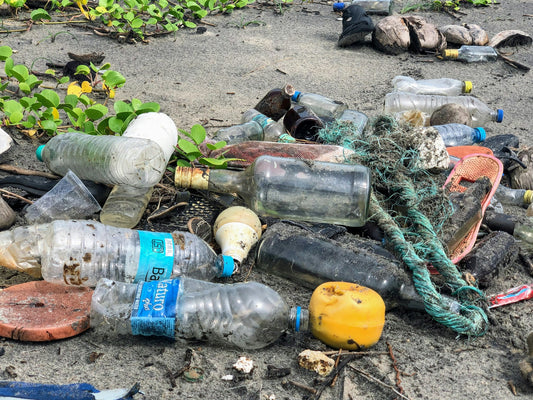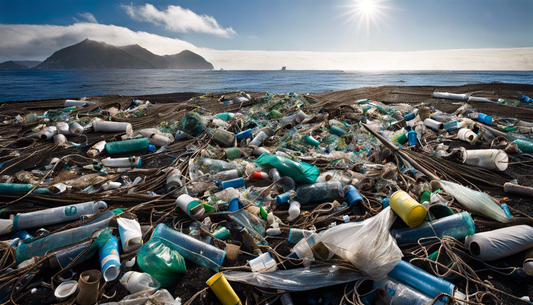Share
It is unquestionable that pollution and climate change affect every single one of us.
For decades, we've been ignoring the warnings of scientists, driving our planet against the wall.
Now, we see the consequences of this ignorance. Every other day we are confronted with news about yet another heat record Yet another catastrophic climate event is looming. Yet another headline warns about the health impacts of plastic pollution.
Unfortunately, you will notice a pattern in all of these headlines if you look closely.
Pollution has a disproportionate impact on poor and marginalized communities.
It is important to pause and recognize.
Recognize the environmental injustice before our eyes. Recognize the significant health and economic consequences that many poor communities face.
You will be surprised by the many shapes that environmental injustice can take today.
Environmental (In)Justice Explained

Environmental Justice (EJ) emerged as a term in the United States during the 1960s. EJ is strongly linked to the civil rights movement around Martin Luther King Jr..
The movement tackled the many injustices that communities of color faced during that time.
Initially, it targeted the unequal distribution of environmental burdens. For example through the dedicated selection of communities of color to host hazardous landfills.
Over time, the concept has gained global recognition as a principle advocating for "...the fair treatment and meaningful involvement of all people regardless of race, color, national origin, or income with respect to the development, implementation and enforcement of environmental laws, regulations and policies."
In many countries, individuals in low-income communities find themselves marginalized. They lack representation in decision-making.
This power imbalance results in a disproportionate concentration of landfills and similar entities in or near these disadvantaged areas.
While numerous factors contribute to this phenomenon, one factor is quite obvious. Decision-makers often reside in wealthier regions and they do not want such facilities near their own communities.
Instead, they campaign for these facilities in poor regions under the cover of creating new jobs.
As a consequence, individuals from low-income communities often bear the burden of working in these facilities.
That also means the same communities suffer the consequences of issues like landfill leakage, inadequate filtration systems, and harmful emissions.
Some wealthier countries have implemented regulations to alleviate these impacts. Alas, some middle- and low-income countries lack the necessary ordinances.
There, marginalized communities are still left with these challenges without adequate support.
Let's unpack the most frequent shapes environmental injustice takes today in the context of plastic pollution and pollution in general.
1. Trading Waste

Many people think that most plastic waste exports are shipped to poor countries, where they pollute the environment. While it is not true that most exports are shipped to poor countries, the ones that are add fuel to the fire.
Trading plastic waste is a vivid global economy. Many countries are exporting and importing millions of pounds of plastic waste every year. You may be surprised that studies found that most trade happens regionally. Europe for example is actually the largest importer and exporter of plastic waste.
The problem here is that wealthier nations mainly trade the valuable plastic waste between one another. That is the recyclable, non-contaminated waste that can be processed into new products.
The low quality waste that cannot be processed regionally is often shipped to Africa, Asia, and Latin America. More than a billion pounds of plastic waste are shipped from the West to low-income countries in these regions.
It is estimated that 5% of ocean plastic can be attributed to plastic exports alone.
Plastic exports neeed to be regulated, and global regulations have started to show an impact. Like the Basel Convention, which needs the consent of the destination country, before allowing the export of contaminated waste.
By the way: plastic waste is by far not the only waste we export to developing countries. Nigeria, for example is famous for mountains of electronic waste that are polluting vast areas.
What is often forgotten though is that waste exports are only adding fuel to a big fire that is burning in marginalized communities already.
2. Mismanaged Waste

That (sometimes literal) fire is called mismanaged plastic waste (MPW).
Many studies have investigated the link between pollution and poverty. If we want to fight pollution, we need to fight poverty and MPW is a prime example for that.
MPW is plastic that is not incinerated, recycled or dumped on a in a controled manner and has a high risk of polluting our nature. This is especially prolematic, when waste is burned on the streets emitting poisonous fumes or when rivers transport plastic waste into our oceans. There it breaks down into microplastic and kills marine wildlife.
Almost a quarter of the world's plastic waste is mismanaged. A comparison of MPW and GDP per capita, reveals an interesting pattern.
The GDP (Gross Domestic Product) is basically the total value of all the goods and services produced in a country in a year. GDP per capita takes that total value and divides it by the population of the country.
So, it gives you an idea of the average wealth per person in that country.
In the graph below, we can easily see that MPW is disproportionately affecting poor and developing countries.
You can see that from the many dots in the bottom right of the graph. The richer a country, the less MPW it produces per person (with a few outliers like Turkey).
The same is true for the opposite.
Take Comoros as an example. It is one of the poorest countries in the world and the West African nation has the highest amount of MPW per person in the world. With almost 70kg of MPW per person, the pollution is equivalent to 4500 empty plastic bottles per person per year.
The country has been struggling to ome up with a plan to resolve its plastic problem for years.
And with MPW come many other problems, like spreading diseases, polluted food sources, lack of clean drinking water. In fact, MPW kills up to a million people every year, mainly in the global South.
You will ask yourself: What the hell do I have to do with mismanaged plastic waste in the Comoros Islands?
3. How Corporate Greed is Fueling the Plastic Addiction

To answer that question, let's take a look at the Philippines, who are dealing with a similar problem.
It will show how the greed of western corporations can choke a whole nation.
The country has the fourth largest amount of mismanaged plastic waste per person and is the world's largest emitter of Ocean Plastic.
What's fascinating is that a staggering 52% of household waste in the Philippines is comprised of plastic sachets.
Sachets are tiny packages of food or cosmetics that only contain single portions (similar to what you may know from ketchup or mayo).
This wide-spread use of plastic sachets in the Philippines, has been fueled by the big consumer goods companies based in the West.
Unilever is widely credited as being one of the first companies to market plastic sachets, with the introduction of small Shampoo portions for 1ct in the 80s. The small packages were considered convenient and affordable and have since flooded the market.
Other consumer giants like Nestlé and Procter & Gamble of course didn't think twice, when they also jumped on the sachet bandwagon.
Today, more 855 billion plastic sachets are sold every year across Africa, Asia and the Middle East. Enough to cover the whole surface of the earth.
And while a majority of profts go to shareholders in the West, the affected countries are left with environmental havoc. They are lacking the resources and infrastructure to manage the plastic flood.
In the Philippines, 114 million Filipinos dispose of 164 million sachets every day.
This has resulted in significant environmental consequences. Waterways are clogged, wildlife is harmed, and the tourism and fisheries sectors are at risk.
In other words: The whole country is collapsing, big western corporation found an opportunity to squeeze money out of poor economies.
Unfortunately, pastic sachets are by far not the first time that the global North exploited deveoping countries for more profits.
4. Exploitation and Pollution Go Hand in Hand

We could write a whole book about the many ways the West exploited Africa, Asia, and Latin America (maybe we will...).
Here are two categories that should cover most of it.
Cheap Labor:
Many countries are bearing the burden of pollution caused by outsourced production.
One of the most prominent examples of that practice is the fashion industry. Fast fashion brands like Zara and H&M have a history of outsourcing to countries like Bangladesh to produce cheap fashion items.
Under the promise of economic prosperity, these countries produce more and more products to feed the Western overconsumption.
Because of the scale of production and lack of regulations, they then have to live with the environmental consequences.
Sometimes these consequences are assuming biblical proportions, like rivers turning black and hundrets of inhabitants getting sick from contaminated water.
Resource Exploitation:
The demand for natural resources like gold, cobalt, uranium, or wood has led to the exploitation and extraction of resources in many countries.
Not only does that contribute to social conflict and humanitarian crises that can even lead to decades of civil war.
There is also a huge misbalance of economic advantages and environmental consequences.
While the lion's share of profits flows to Western corporate giants and corrupt politicians, inhabitants have to live with the environmental impacts.
Air pollution, deforestation, biodiversity loss, and water and soil pollution are just few of the consequences people have to fave.
Pair that with horrific working conditions and you have the perfect recipe for a miserable future.
Environmental Justice is Human Justice
In the preceding chapters, we've shed light on the complex causes of environmental injustice and how the West is contributing.
The need for systemic change is undeniable.
It spans from the disproportionate burden of plastic pollution on marginalized communities to corporate greed driving unsustainable consumption patterns.
Fair Regulations:
We need clear regulatory standards for foreign direct investments (FDI) on a global level that prevent the exploitation of lax environmental regulations in host countries.
These need to include requirements for pollution control, waste management, and adherence to international environmental agreements.
Additionally, these regulations need to support fairness of profits and burdens.
An example to achieve fairness could be ensuring technology transfer that allows FDI to improve economies in host countries beyond purely monetary benefits.
Yes, forward-looking regulations are essential.
But rich nations also need to make up for damages already caused by decades of living "higher, faster, further".
A recent example is the loss and damages fund agreed during COP28 to compensate vulnerable countries for damages from climate change.
Corporate Responsibility:
Corporate Responsibility for social and environmental impact can play a significant role in addressing global pollution by encouraging businesses to adopt sustainable practices.
Companies need to be accountable through transparent reporting.
Examples are metrics around carbon emissions, human rights, and other indicators that measure sustainable growth.
The big question is always: Who holds corporations accountable? Many will not do good for the sake of good.
If it's not the government, it needs to be the consumer.
Consumer Awareness:
In the end, consumers' awareness can tip the scale by driving demand into the right direction.
By educating yourself about the environmental and social impact of products and services, you can make dedicated purchasing decisions and vote with your wallet.
As a consequence, the increased support for sustainable products can slowly move the world economy towards a more sustainable future.
What do you think? Should rich countries be responsible for damages caused by overconsumption?
If you want to engage in the discussion, feel free to leave a comment below.
We hope you enjoyed this article. If you want to read more like this, make sure to check out our Blog and follow us on Instagram. If you are interested in truly sustainable products, check out our Shop.








